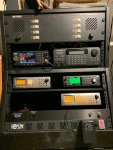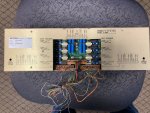No, not that way.
Found myself a desktop rack console ($20) and figured it would be just the thing for the scanners. From top to bottom:
1. Zetron Model 27 Receiver Monitor panel. This can handle up to 8 receivers mixed down to two speakers; each receiver has a mute button (which when pressed mutes the audio from that channel and lights the top LED next to it), while activity on that receiver flashes the bottom LED next to the corresponding button.
2. SDS200 and Pro-2035. The SDS200 is used for general scanning, while the 2035 (equipped with an Optoscan OS-535 board) is used for airband monitoring and snooping on data modes (more on this in a moment).
3. Pro-197 and BCD996XT. The Pro-197 is used for local fire monitoring, and the BCD996XT for local law monitoring.
4. An empty space and another Pro-197. I haven't figured out what to put in the empty space (possibly my Home Patrol 1), but the other Pro-197 is used for rail monitoring and other general scanning.
5. I/O panel. Left to right: A DB9 connected to the OS535 connector on the 2035; an RJ45 port connected to the network switch (for my laptop if I need to use it for something); empty space for more neat stuff; a panel mount RCA jack which is connected to the the discriminator output on the Pro-2035; a BNC panel mount antenna connector hooked up to one of the spare outputs on the drop amp (the unused outputs on the drop amp have 75 ohm terminators on them, as does this BNC connector when it's not in use).
6. A Tripp-Lite rack-mount power strip, with six grounded outlets on the front, and five more on the back.
The five scanners are connected to a wide-band antenna in the attic through an Electroline EDA FT-08100 8-port drop amp which passes 5-42 and 54-1000 MHz. DC power for the radios comes from a large gel-cell battery connected to a West Mountain Radio RigRunner through a gadget similar to the West Mountain Radio PWRgate (which charges the battery and switches the radios over to battery automatically if AC power goes out).
I've tested the Electroline drop amp next to a Stridsberg, and found it to perform just as well; if there's any difference, I couldn't hear it. The best thing is the EDA was only about $25 on eBay.
I thought about using rack-mount panels cut for the scanners, but they cost over $100 each; the 10" deep rack shelves I ended up using were $15 each on eBay, and allow me to fit more receivers into the rack.
The empty space in the I/O panel may eventually hold a small panel-mount DC voltmeter and a panel mount Anderson powerpole.
Now for the rest of the shack.

Found myself a desktop rack console ($20) and figured it would be just the thing for the scanners. From top to bottom:
1. Zetron Model 27 Receiver Monitor panel. This can handle up to 8 receivers mixed down to two speakers; each receiver has a mute button (which when pressed mutes the audio from that channel and lights the top LED next to it), while activity on that receiver flashes the bottom LED next to the corresponding button.
2. SDS200 and Pro-2035. The SDS200 is used for general scanning, while the 2035 (equipped with an Optoscan OS-535 board) is used for airband monitoring and snooping on data modes (more on this in a moment).
3. Pro-197 and BCD996XT. The Pro-197 is used for local fire monitoring, and the BCD996XT for local law monitoring.
4. An empty space and another Pro-197. I haven't figured out what to put in the empty space (possibly my Home Patrol 1), but the other Pro-197 is used for rail monitoring and other general scanning.
5. I/O panel. Left to right: A DB9 connected to the OS535 connector on the 2035; an RJ45 port connected to the network switch (for my laptop if I need to use it for something); empty space for more neat stuff; a panel mount RCA jack which is connected to the the discriminator output on the Pro-2035; a BNC panel mount antenna connector hooked up to one of the spare outputs on the drop amp (the unused outputs on the drop amp have 75 ohm terminators on them, as does this BNC connector when it's not in use).
6. A Tripp-Lite rack-mount power strip, with six grounded outlets on the front, and five more on the back.
The five scanners are connected to a wide-band antenna in the attic through an Electroline EDA FT-08100 8-port drop amp which passes 5-42 and 54-1000 MHz. DC power for the radios comes from a large gel-cell battery connected to a West Mountain Radio RigRunner through a gadget similar to the West Mountain Radio PWRgate (which charges the battery and switches the radios over to battery automatically if AC power goes out).
I've tested the Electroline drop amp next to a Stridsberg, and found it to perform just as well; if there's any difference, I couldn't hear it. The best thing is the EDA was only about $25 on eBay.
I thought about using rack-mount panels cut for the scanners, but they cost over $100 each; the 10" deep rack shelves I ended up using were $15 each on eBay, and allow me to fit more receivers into the rack.
The empty space in the I/O panel may eventually hold a small panel-mount DC voltmeter and a panel mount Anderson powerpole.
Now for the rest of the shack.



